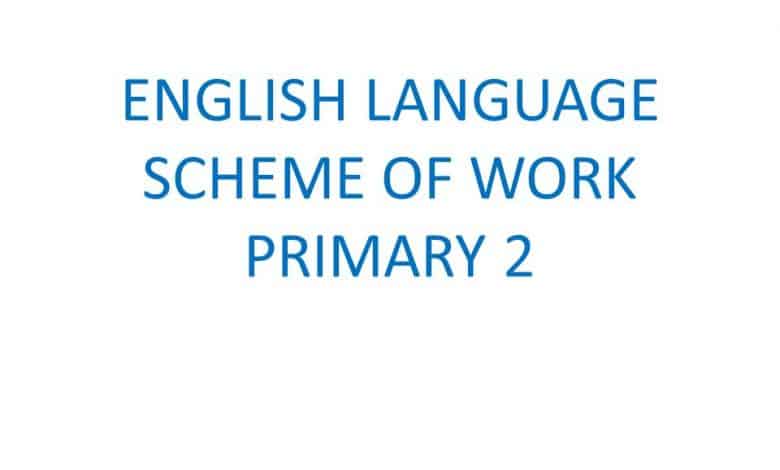Scheme of Work For English Language Primary 2

This article provides you with the scheme of work and the curriculum for the first term, second term, and third term for primary 2 pupils.
First Term
Phonemic Awareness I and II
- Using songs and rhymes to identify sounds
- Using sounds and combinations of sounds to decode unknown words.- Production of sounds /a/ as in bat; /s/ as in sat.
- Pronunciation of given words correctly
Phonics I and II
- Pronunciation of consonants and consonant clusters. – production of consonant sounds in isolation, words and in context e.g. /b/, /d/ in words e.g. bed, dog. – pronunciation practice on consonant clusters e.g. bl –blade, /br/ – bread, /dr/ -dry /fr/ – frog, /f/ – flood e.g. a. This blade is very sharp. b. I ate bread this morning. c. Frogs live in water.
- Identification of mono, bi-syllabic and multi syllabic words: – identification of mono and bi-syllabic words e.g. go/sit, teacher/under. – reading of multisyllabic words such as umbrella, diamond etc. – basic syllabication rules. – basic decoding skills.
Fluency
- Reading different kinds of texts: – fiction, – non fiction, – informational etc.
- Repeated reading and fluency building strategies: – reading class appropriate passages, – answering factual questions on the passages
Comprehension
- Answering factual questions from class appropriate passages, stories/rhymes e.g. simple passages from the course book a short poem or rhyme on food safety etc.
- Listening to and retelling stories e.g. – Talk about facts leaned in information text (e.g. danger of food contamination/poisoning). – Identifying the characters and events in the story. – Explaining the beginning contents and closing of a story.
- Oral comprehension/Games. – reading passages that will interest the pupils. – reading class appropriate stories to the pupils.
- Reading class appropriate texts: – reading simple sentences on series of informational texts (e.g. dangers of wrong use of pesticides). – answering factual questions on the sentences.
Second Term
Comprehension I and II
- Reading class appropriate passages and identifying facts and other kinds of information in them e.g. The use of herbal medicines, occupations, customs and traditions of the people.
- Application of comprehensive passages to both narrative and expository passages reading simple passages based on narrative and expository texts.
Vocabulary I and II
- Antonyms and synonyms: – simple passages containing antonyms and synonyms. – simple sentences of antonyms and synonyms.
- Registers in different subjects: – reading passages based on registers of medicine, law, computer, etc. – Multiple meaning words (e.g. bank account, river bank).
Concept of print
- Basic concepts of print e.g. – Picture reading, identification of signs e.g. road signs. – Interpretation of diagrams charts and graphs to give information. – Parts of a book title, author, illustrations etc. – Meaning of paragraph and passage.
- Description of objects according to their colours
Using sounds and combinations of sounds to spell and pronounce words
- Production of sound /a/ as in bag; /a:/ as in bark. Spelling and pronunciation of given words correctly
Answering factual questions from simple passages stories/rhymes read
- A simple passage from the course book. A short poem or rhymes.
Asking and answer questions on present, past and future actions
Pupils should be able to:
- answer questions on present actions.
- answer questions on past actions.
- answer questions on future actions.
- respond to ‘what’ questions on the above actions
Read: List of Nursery and Primary School Subjects
Third Term
Expressing ownership
- Using possessive pronouns as (singular) e.g. my, his, hers, mine.
- Using possessive pronouns as (plurals) as ours, theirs, yours.
Songs and rhymes
- Rhymes based on some virtues e.g. nature, love.
- Songs that can help the pupils to learn sounds in words.
Listening to and telling stories
- Telling story using an appropriate style of narration.
- Identifying the characters and events in the story.
- Explaining the beginning content and closing of a story
Simple oral comprehension/games
- Reading passages that will interest the pupils. Reading short stories to the pupils
Introducing individuals
- Guiding pupils to introduce themselves using words like, “My name is Mary” “This is my friend” to introduce themselves
Introducing adjective and adverbs
Adjectives e.g.
- this is a beautiful dress.
- the car is yellow
Adverbs:
- he eats slowly
- she runs fast
Use of regular and irregular plurals of nouns
- Regular plurals, plurals with‘s’ ending e.g. ball/balls, girl/girls.
- Irregular plurals, e.g. man/men; ox/oxen, child, children
Simple present and past tense of common verbs
- Production of simple present and past tense of common verbs in tabular form e.g. run/ran; come/came
Correct use of apostrophe in possessives
- Apostrophes in possessives e.g. i. It is the boy’s toy, ii. It is the boys’ college
Using the present continuous tense
- Identification and use of present continuous tense e.g. I am eating, He is running.
- Guided examples of present continuous tense
